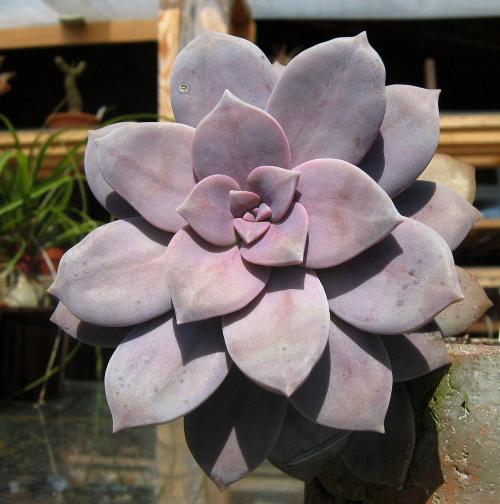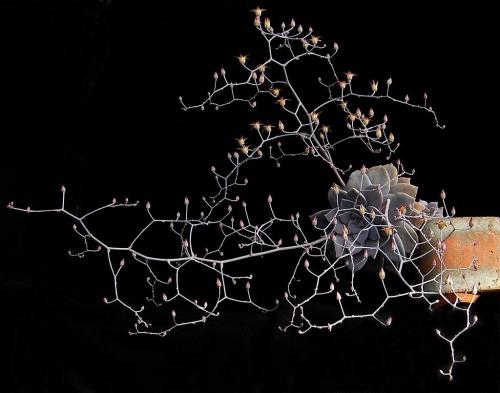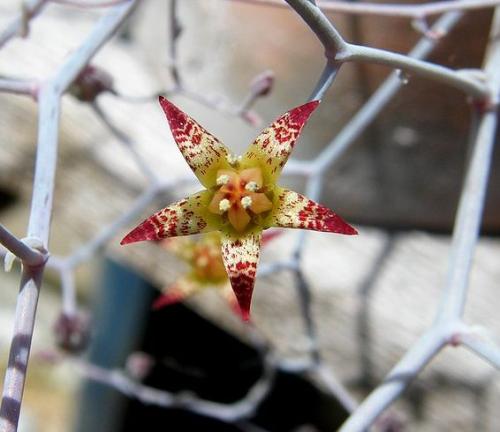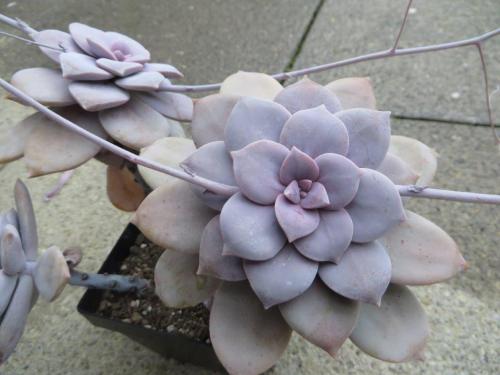SUPERBUM Acevedo Rosas, 2003
Synonyms:
G. pentandrum ssp. superbum Kimnach (1987)
G. rosanevadoensis Vázquez et al., 2021 see note below.
Distribution : Mexico (Jalisco); 1200m
Description :
Plant schrubby, branching basally, to 20 cm tall or more, entirely glabrous.
Stems branching mostly from base, suberect to semidecumbent, 10 – 12 mm thick near base, 5 – 10 mm thick near apex, prominently marked with elliptical, tan leaf-scars.
Leaves 12 – 20 on apical 1 – 2 cm of stem, the more apical ones in a dense, nearly flat rosette, the lower ones separated 5 – 8 mm at base, soon deciduous, oblong-obovate, with a deltoid mucro, heavily glaucous with purplish bloom, amber-green beneath wax, 4 – 6 cm long, 2 – 2.5 cm wide at widest part 1.5 – 2 cm from apex, 5 – 7 mm thick at thickest part ca. 5 mm from apex, the upper surface nearly flat, the lower surface more or less strongly convex.
Inflorescences : Flowering stems up to 3 to a stem, erect or ascending-horizontal, 30 – 40 cm long and ca. 20 – 30 cm wide, peduncle 7 – 12 cm long, bracts lacking on basal 2 – 3 cm, ca 10 above, similar to leaves but smaller, branches 12 – 15, ca. 2 – 4 cm apart, 5 – 9-flowered, pedicels 10 – 14 mm long.
Flowers : Sepals appressed to petals, 3 – 4 mm long, glaucous, corolla ca 9 mm long when unopened, 15 – 16 mm wide when expanded, petals 5 (or 6), triangular, the upper surface greenish yellow, the apical millimeter reddish brown, the next 2 mm with 2 – 3 crossbands and scattered dots of same colour.
Cytology : n = 64
Note :
The recently published article by Vázquez et al. (Phytotaxa 496 (2): 159-169), describing a new Graptopetalum species as "G. rosanevadoensis", leaves much to be desired :
1. The name is not correct, it should read "rosanevadoense".
2. G. glassii is said to be one of the morphologically closest species, which is simply nonsense. Obviously the authors ignore the meaning of the term "morphology".
3. The authors state that G. superbum and the "new" species are similar in habit, plant size, rosette diameter, leaf lenght and form, but differ in the number of leaves per rosette, stem surface, stem diameter, leaf colour, inflorescence length and number of branches per inflorescence. However these differences do by far not justify the establishment of the new plant as a new species. They rather suggest that what is known as G. superbum is more variable than has been assumed up to now and that the new plant could be considered a variety of G. superbum. There is not even a rudimentary discussion of this issue.
MB




Photo Margrit Bischofberger